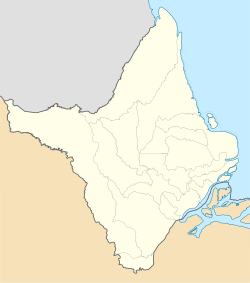페르세이로59번길
59 Persei| 관측 데이터 에폭 J2000 이쿼녹스 J2000 | |
|---|---|
| 별자리 | 페르세우스 |
| 우측 상승 | 04h 42m 54.33987s[1] |
| 탈위임 | +43° 21′ 54.4795″[1] |
| 겉보기 크기 (V) | 5.30[2] |
| 특성. | |
| 진화 단계 | 주계열[3] |
| 스펙트럼형 | A1Vn[4] |
| B-V색지수 | 0.028±0.005[2] |
| 아스트로메트리 | |
| 방사 속도 (Rv) | +13.2±3[2].1km/s |
| 고유 운동 (μ) | RA: +30.826[1] mas/yr Dec.: -50.576마스[1]/yr |
| 시차 (π) | 12.7294 ± 0.1774[1] 마스 |
| 거리 | 256 ± 4 리 (79 ± 1 pc) |
| 절대치수 (MV) | 0.99[2] |
| 세부 사항 | |
| 미사 | 2.58[5] M☉ |
| 반지름 | 2.5[6] R☉ |
| 루미도 | 41.4+11.7 −9.2[3] L☉ |
| 표면 중력 (log g) | 4.05±0.14[5] cgs |
| 온도 | 10,734±365[5] K |
| 회전 속도 (v sin i) | 212km[3]/s |
| 나이 | 198[5] 마이어 |
| 기타 지정 | |
| 데이터베이스 참조 | |
| 심바드 | 자료 |
59 페르세이는 페르세우스 북쪽 별자리에 있는 점성계 이항성계로[8] 추정되는 행성계다.육안으로는 겉보기 규모 5.30의 희미한 백색 별로 보인다.[2]이 별은 시차(parallax)를 기준으로 태양으로부터 약 256광년 떨어진 곳에 위치하며,[1] 방사상 속도 +13 km/s로 더 멀리 떠내려가고 있다.[2]
이것은 항성 분류가 A1Vn인 일반 A형 주계열성으로,[4] 핵심 수소를 융합하고 있는 별이다.'n' 접미사는 빠른 회전으로 인한 "불가결한" 선을 나타내며, 212 km/s의 예상 회전 속도를 가지고 있다.[3]이 별은 태양 질량의 2.58배, 태양 반지름의 약 2.5배인[5][6] 약 1억[5] 8천 8백만년 된 것이다.그것은 유효 온도 10,734 K로 광권으로부터 태양의 41배[3] 광도를 방사하고 있다.[5]
참조
- ^ a b c d e f Brown, A. G. A.; et al. (Gaia collaboration) (August 2018). "Gaia Data Release 2: Summary of the contents and survey properties". Astronomy & Astrophysics. 616. A1. arXiv:1804.09365. Bibcode:2018A&A...616A...1G. doi:10.1051/0004-6361/201833051.이 소스에 대한 가이아 DR2 기록 VizieR.
- ^ a b c d e f Anderson, E.; Francis, Ch. (2012), "XHIP: An extended hipparcos compilation", Astronomy Letters, 38 (5): 331, arXiv:1108.4971, Bibcode:2012AstL...38..331A, doi:10.1134/S1063773712050015, S2CID 119257644.
- ^ a b c d e Zorec, J.; Royer, F. (January 2012), "Rotational velocities of A-type stars. IV. Evolution of rotational velocities", Astronomy & Astrophysics, 537: A120, arXiv:1201.2052, Bibcode:2012A&A...537A.120Z, doi:10.1051/0004-6361/201117691, S2CID 55586789.
- ^ a b Cowley, A.; et al. (April 1969), "A study of the bright A stars. I. A catalogue of spectral classifications", Astronomical Journal, 74: 375–406, Bibcode:1969AJ.....74..375C, doi:10.1086/110819
- ^ a b c d e f g David, Trevor J.; Hillenbrand, Lynne A. (2015), "The Ages of Early-Type Stars: Strömgren Photometric Methods Calibrated, Validated, Tested, and Applied to Hosts and Prospective Hosts of Directly Imaged Exoplanets", The Astrophysical Journal, 804 (2): 146, arXiv:1501.03154, Bibcode:2015ApJ...804..146D, doi:10.1088/0004-637X/804/2/146, S2CID 33401607.
- ^ a b Pasinetti Fracassini, L. E.; et al. (February 2001), "Catalogue of Apparent Diameters and Absolute Radii of Stars (CADARS)", Astronomy and Astrophysics (Third ed.), 367 (2): 521–524, arXiv:astro-ph/0012289, Bibcode:2001A&A...367..521P, doi:10.1051/0004-6361:20000451, S2CID 425754.
- ^ "59 Per". SIMBAD. Centre de données astronomiques de Strasbourg. Retrieved 2019-03-30.
- ^ Eggleton, P. P.; Tokovinin, A. A. (2008), "A catalogue of multiplicity among bright stellar systems", Monthly Notices of the Royal Astronomical Society, 389 (2): 869, arXiv:0806.2878, Bibcode:2008MNRAS.389..869E, doi:10.1111/j.1365-2966.2008.13596.x, S2CID 14878976.


